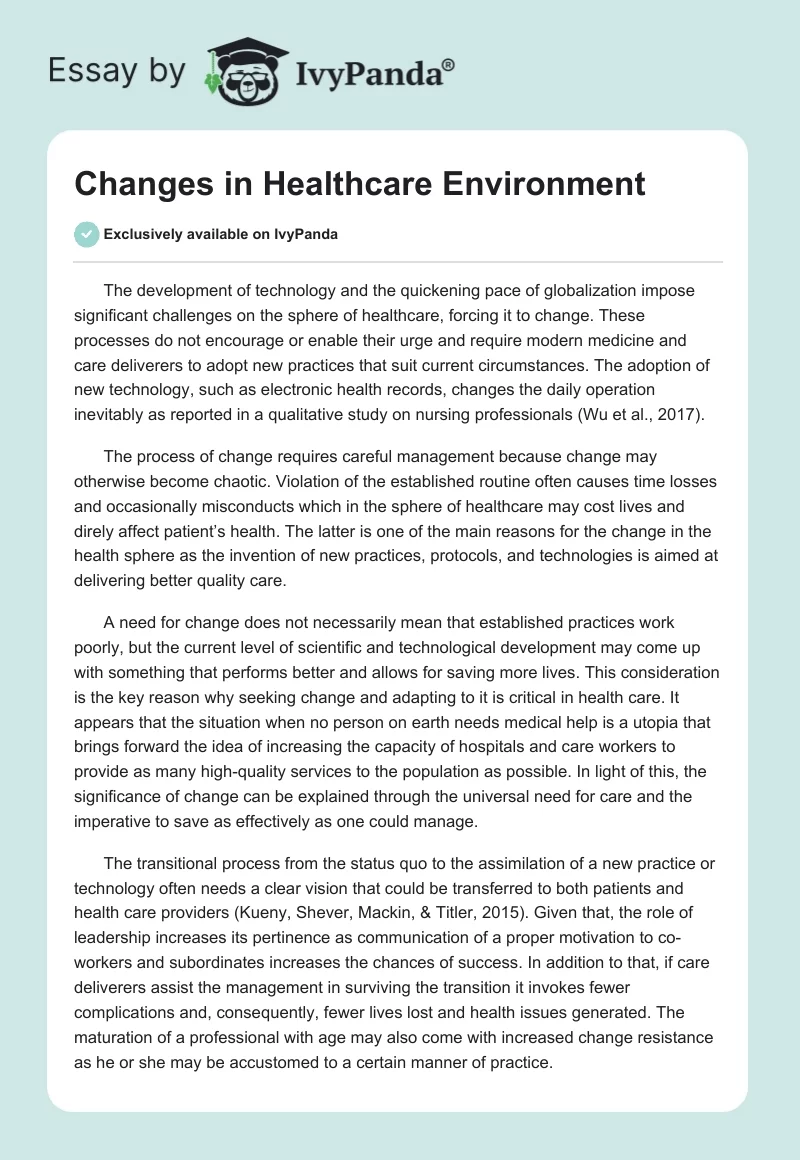The development of technology and the quickening pace of globalization impose significant challenges on the sphere of healthcare, forcing it to change. These processes do not encourage or enable their urge and require modern medicine and care deliverers to adopt new practices that suit current circumstances. The adoption of new technology, such as electronic health records, changes the daily operation inevitably as reported in a qualitative study on nursing professionals (Wu et al., 2017).
The process of change requires careful management because change may otherwise become chaotic. Violation of the established routine often causes time losses and occasionally misconducts which in the sphere of healthcare may cost lives and direly affect patient’s health. The latter is one of the main reasons for the change in the health sphere as the invention of new practices, protocols, and technologies is aimed at delivering better quality care.
A need for change does not necessarily mean that established practices work poorly, but the current level of scientific and technological development may come up with something that performs better and allows for saving more lives. This consideration is the key reason why seeking change and adapting to it is critical in health care. It appears that the situation when no person on earth needs medical help is a utopia that brings forward the idea of increasing the capacity of hospitals and care workers to provide as many high-quality services to the population as possible. In light of this, the significance of change can be explained through the universal need for care and the imperative to save as effectively as one could manage.
The transitional process from the status quo to the assimilation of a new practice or technology often needs a clear vision that could be transferred to both patients and health care providers (Kueny, Shever, Mackin, & Titler, 2015). Given that, the role of leadership increases its pertinence as communication of a proper motivation to co-workers and subordinates increases the chances of success. In addition to that, if care deliverers assist the management in surviving the transition it invokes fewer complications and, consequently, fewer lives lost and health issues generated. The maturation of a professional with age may also come with increased change resistance as he or she may be accustomed to a certain manner of practice.
Change resistance in such workers may undermine the transition or at least decelerate its onset, which again underlines the critical nature of leadership in facilitating change. Conversely, as changes happen more rapidly, there arises a standing need for effective leadership and specialists who can assist organizations in establishing new standards of care, which explains the relevance of the alteration concept in this regard.
Change as the process that often leads to dismantling the previously established traditions and norms leave an imprint on the manner that a system reacts to such paradigmatic shifts. In practice, an accumulation of a sufficient number of changes seems to lead to significant structural alterations that require new roles in emerging. Professionals that look at an issue from a different perspective are often able to push the sphere forward and critically assess and synthesize the experience to create new knowledge.
Scully (2015) argues that such a role may be occupied by nursing leaders. The profession that has always been supplementary to physicians and maintained a given number of care tasks now evolved to address the challenges of the present time. The need for a nurse leader is substantiated by the change in the way the patient is serviced. Machines powered by artificial intelligence claim to replace more and more daily choirs traditionally performed by nurses such as blood pressure, heart rate, drug administration, and so forth. This process causes nurses to adapt and acquire new skills and competencies that allow them to make the increasingly automated process of care delivery more effective.
Despite the ongoing automation, change in health care, human personnel still maintain the dominant role in overseeing the process of caregiving. The collaboration of professionals with an aspiration to provide medical assistance to a patient or their family remains a modern challenge that requires a solution. In light of the tendency of hospitals to emphasize a team approach, professionals with a variety of skills and competencies and first-hand knowledge of patient needs enable nurses to become team leaders and demonstrate expertise in handling a new role. Yet, the trend for digitalization not only inspires the need for more nursing leaders but also poses different demands to their skillset and knowledge.
This factor causes alterations in the system of education and training of such professionals. For instance, scholars tend to note the increased role of nursing informatics as a course that gives young leaders a competitive advantage on the job market (Baker, Charlebois, Lopatka, Moineau, & Zelmer, 2016). Thus, change as a concept is imbued with critical value and a notion for the professional development of nurses in the sphere of leadership to reduce the chaos of transitional process and maintain patient care level at a stable, high-quality level.
References
Baker, C., Charlebois, M., Lopatka, H., Moineau, G., & Zelmer, J. (2016). Influencing change: Preparing the next generation of clinicians to practice in the digital age. Healthcare Quarterly, 18(4), 5-7.
Kueny, A., Shever, L. L., Mackin, M. L., & Titler, M. G. (2015). Facilitating the implementation of evidence-based practice through contextual support and nursing leadership. Journal of Healthcare Leadership, 7, 29-35.
Scully, N. J. (2015). Leadership in nursing: The importance of recognising inherent values and attributes to secure a positive future for the profession. Collegian, 22(4), 439-444.
Wu, P. Y., Cheng, C. W., Kaddi, C. D., Venugopalan, J., Hoffman, R., & Wang, M. D. (2017). Omic and electronic health record big data analytics for precision medicine. IEEE Transactions on Biomedical Engineering, 64(2), 263-273.


